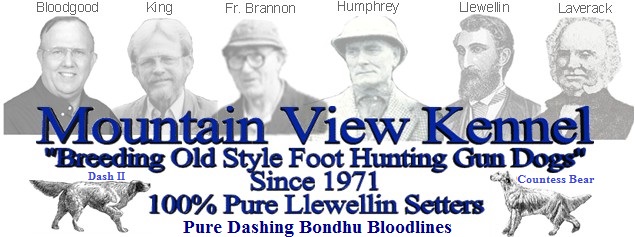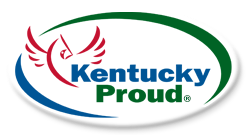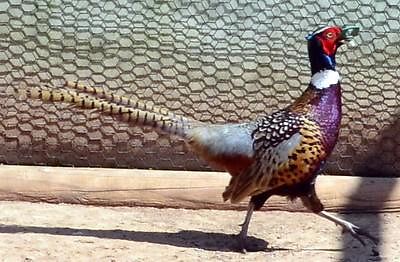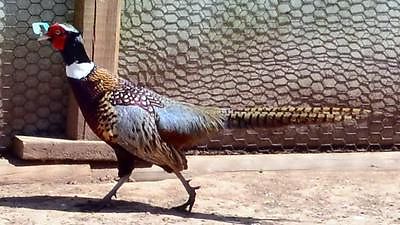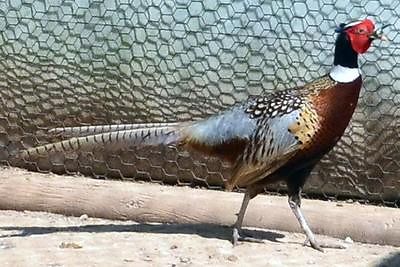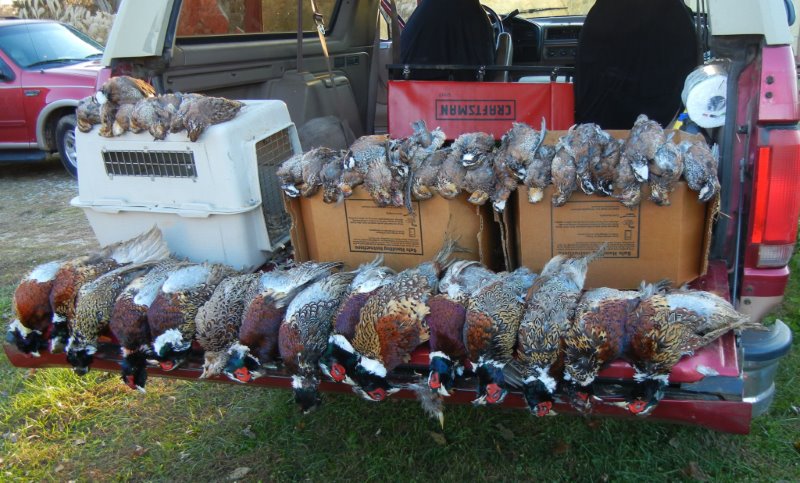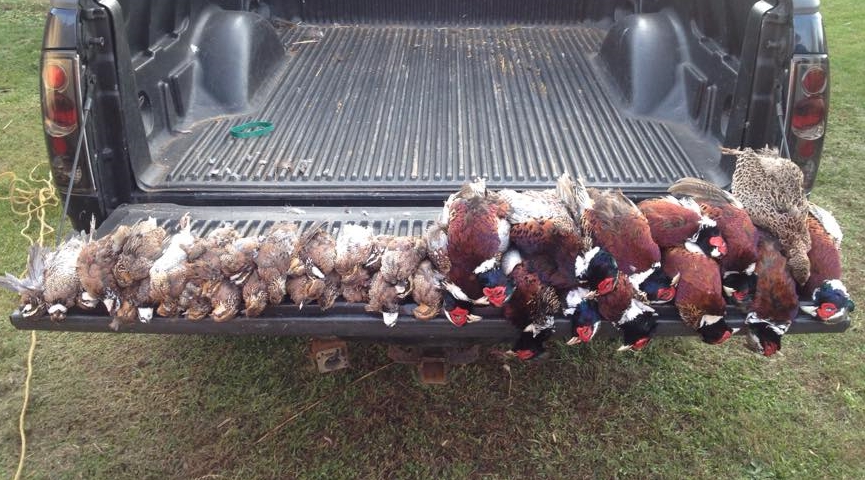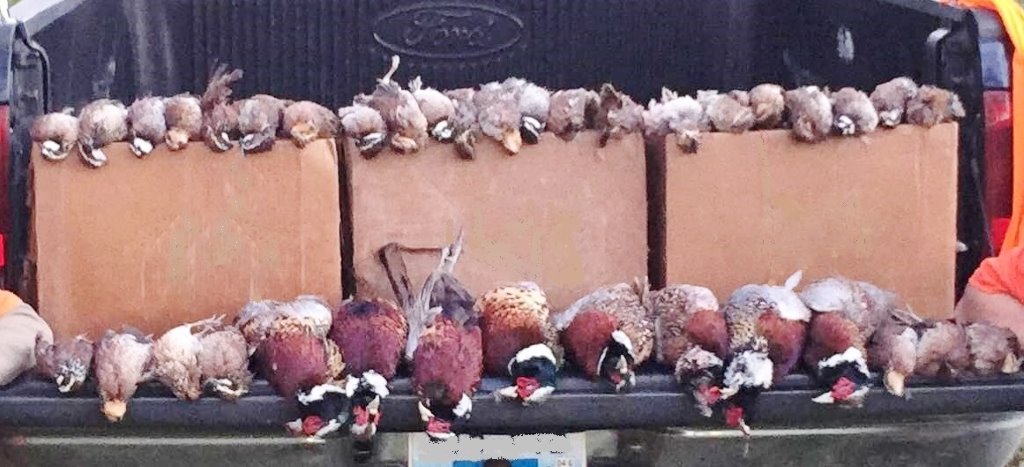Mountain View is a Kentucky Proud Game Farm!
Our Wild Stock
Kansas Ring-neck Pheasants
We have had a lot of our Llewellin Setter customers ask us to sell eggs and chicks from our Wild Kansas Ring-necked Pheasant stock. These are the same Pheasants we stock, hunt and train on annually with our great Llewellin's Setters!
Note, their slender build, dark green neck with defined ears, gray crest, thick white ring, well feathered and long tailed, blue rump, gray shoulder, and orange-gold side breast feathers.
Raised on 30% Purina Game Bird Startina and 20% Purina Flight-Conditioner and no artificial light.
“Wild Stock Kansas Ring-necked Pheasants”: These birds were originally obtained from nests found in West Kansas from no stocking area of the state where true wild populations are. The hens were killed while mowing hay and the eggs were collected, hatched, raised, to produce them in captivity. They are smaller, leaner, and more colorful than the common Chinese Ring-neck strains sold at most game farms, resulting in an awesome wild type game bird that requires less food both in captivity and in the wild. They are exceptional hardy, fast strong fliers, with rich deep brilliant color, markings, and strong feathering with extra strong long tail feathers. They are highly intelligent and have strong natural instincts to survive and reproduce in both captivity and wild. They prefer to sit tight in good cover instead of running, and prefer to roost in trees at night away from predators. We have yet to see any run on our Llewellin Setters in good cover. This makes them perfect for dog training, stocking lands, preserves, Taxidermy mounting, and have exceptional flavor for the table.
When raised without artificial light the males weigh approximately 2.0-2.25 and hens 1.5-1.75 lbs. when mature, resulting in a true wild size Chinese Ring-neck Pheasant. They are the best we have found in over 48 years of breeding top game birds, especially for training bird dogs. Roosting at night in trees away from predators. Hatching eggs are collected twice each day, stored in cool room, turned often and shipped fresh no more than 1-3 days old.
 A pair of our Wild Stock Kansas Ring-Neck Pheasants with peepers on.
A pair of our Wild Stock Kansas Ring-Neck Pheasants with peepers on.
Please, check your State Laws for ownership requirements for Ringed-necked Pheasants before ordering. Many States require low fee Game Bird Permits to own them. No Permits required in Kentucky! You can purchase, own, breed, sell, stock, and even shoot them (KYFW Hunting License required) all year a round in KY, making them excellent for training dogs out of quail season and expose them to Pheasants for future hunts. Payment on orders are non-refundable.
Place your 2025 Orders Now!
Hatching eggsShipping Available USPS Priority Mail
April – May LIMITED SUPPLY!
Minimum 36 hatching egg orders
32+4 free = 36 eggs Total for $35.00 + $2.10 Tax = $37.10 Total if picked up, or add $20. S/H USPS Priority Mail = $57.10 total shipped to lower 48 US states only.
66+6 free = 72 eggs Total for $65.00 + $3.90 Tax = $68.90 Total if picked up, or add $25. S/H USPS Priority Mail = $93.90 total shipped to lower 48 US states only.
Hatching Eggs are Shipped in Foam (see photo). Picked up eggs are in paper egg trays for no extra charge.
No Kentucky Game Bird Permits required to purchase, own, trade, stock, or to sell Pheasants or for other non-native game birds. KY Hunting License is required to hunt pheasants, but no closed season or daily limits in KY.
If outside of KY, please check your local, county, and state laws before placing an order. Payments for orders are non-refundable.
To order, send Zelle to mvcr@scrtc.com Marie Bloodgood, or make checks payable to:
Mountain View Kennel, LLC.
11290 N. Dixie Hwy.
Bonnieville, KY 42713
Now Shipped in foam wrapped in bubble wrap!
Each egg is surrounded including the top, bottom, and completely
around each egg by foam, assuring the best shipping possible.Shown here with foam top removed and our pheasant eggs installed.
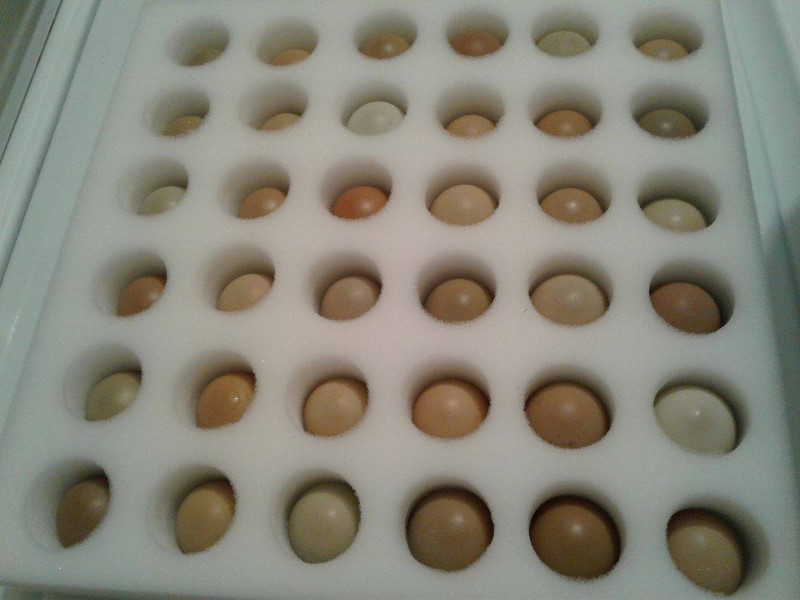
Kentucky residents and any orders picked up must add 6% sales tax.
Only Shipments out of state are exempt from sales tax.
Please Note: We will be hatching more chicks with our professional RITE FARM PRO-1056 Incubator and been getting a 98+% hatch rate in it. We only send fresh eggs only a day or two old and we package the eggs the same way we would want our eggs shipped surrounded in foam and bubble wrapped, by Priority Mail. Most shipments have been received unbroken, not even the extra eggs are cracked and most people with good incubators have had very good hatch rates of 80-90+%, but unfortunately, we cannot guarantee your hatch rate because of handling during shipping and incubation out of our control, but have been receiving excellent to good hatching reported on 95% of the eggs we shipped in the past 8 years. With only about one order in one hundred being no good. We have shipped replacement orders at a reduced price with proof, but the USPS should be contacted for broken and crushed boxes. We NOW ship our eggs in foam, with each egg surrounded in foam and then wrapped in bubble wrap. The best possible way to ship hatching eggs. Note these foam egg cartons are specially made for shipping Pheasant eggs and come in 36 egg total unit size and cost $5.50 just for the foam, so our eggs will be shipped in 36, and 72 egg units, all surrounded in foam and bubble wrap. This is the most eggs we sell at a time, because we only ship fresh eggs collected between 24-48 hours. We ship eggs on Monday-Wendesdays, USPS Priority Mail so they will not be held in a hot truck over the weekend.
We can add a cool pack in very hot weather, for an additional $5.00, it will keep your eggs about 20 degrees cooler. Will make a big difference in your hatch rate if it is hot out.
-------------------------------
Day-Old Pheasant Chicks
Special Order Only!
(Straight Run/as Hatched)
Pre-Orders MUST be paid in full at time of order.NO SHIPPING!
Orders must be made 4-6 weeks in advance for chicks.
MUST be picked up at farm one day after hatch date.
Can set eggs for Saturday Pickup.
(25 chick minimum)
May – June. LIMITED SUPPLY!
25+ Chicks @ $3.50 each + 6% tax
50 Chicks @ $3.00 each + 6% tax
NO SHIPPING!
No Kentucky State Permits required to purchase, own, trade, stock, hunt (Hunting does require a KYFW hunting Lic. unless a land owner), or sell Pheasants and other non-native game birds. This means in KY and many other southern states who do not recognize ring-necked pheasants as native birds, anyone can hunted them year around, without limits. BTW, Kentucky does require an IMPORT permit to import animals, eggs, chicks, and adults into the state of Kentucky, but an import permit is NOT required for purchases within the State!
We live in the Bonnieville township in Hart County of the state of Kentucky and do not require any permits to purchase, own, raise, sell, release, except a KYFW Hunting Lic. to hunt Pheasants off KY land.
We also accept payment by Cash, Certified Bank Check, or bank wire transfer. Only, made out to:
Mountain View Kennel, LLC.
11290 N. Dixie hwy.
Bonnieville, KY 42713
Results from stocking our Wild Stock Ring-neck Pheasants on local Kentucky farms
and hunting them with our amazing pure Dashing Bondhu Llewellin's Setters.
Best survival rates are stocked at 5-6 weeks of age after two weeks in flight pens.
Adults can also be rocked and placed on farms for shooting over a weekend.
Warning, if flushed they will fly out of sight if missed. Not one of these Pheasants has ever run on our dogs while in good cover and all birds were pointed solid without re-pointing and were retrieved by our Setters.
Mike Jr. looking over a day's hunt in 2011. The take of 9 wild stock
Kansas Ring-neck Pheasants (stocked) and 6 Wild Kentucky Bob-White Quail.
Not counting birds missed :)
15 Kansas Ring-necked Pheasants (oops 1 hen, legal in KY, but a no-no) and 30 of our wild stock Alabama Bob-White Quail taken opening day of the 2013 bird season with our Llewellin's Setters.
Not counting birds missed :)
2014 Opening day's take 25 wild stock Alabama Quail and 13 wild stock Kansas Ring-neck Pheasants, (oops 1 hen, legal in KY, but a no-no) , taken with our outstanding Llewellin Setters.
Not counting all the birds missed :)
2015 Opening day's take 30 wild stock Alabama Quail and 8 wild stock
Kansas Ring-neck Pheasants, taken with our outstanding Llewellin Setters.
Not counting birds missed :)
SORRY, WE ARE NOT LICENSED TO SELL, GIFT, OR TRADE OUR AWESOME WILD LIKE BOB-WHITE QUAIL!
If you would like to get some good Northern Bobwhite Quail hatching eggs, we recommend getting them from this Ebay Store. We have purchased their eggs for the past several years and orderd a 1000 eggs this year. They sent 1200 eggs with only 50 cracked and hatched in our new Rite Farm incubator 1119 chicks.
The secret to raising close to wild like birds is #1 starting with great stock and #2 only using natural light (No Heat Lamps) to raise them. Best raised using brooders with thermostatically controlled heaters with a small 7 watt blue or red attraction bulb. That will keep them under heater at night and they won't eat 24/7, resulting in a bird much closer to the original size of the species. A 14 oz. Quail or a 3.5-4 lb. Pheasant will never survive in the wild as well as a 8-10 oz. Quail or a 2-2.5 lb. Pheasant will.
Feeding Quail & Pheasant chicks
We Feed Purina Game Bird foods because they are simply the BEST food to feed them. It cost more, but it's been our experience raising game birds for over 48 years including for NY state conservation department, that the birds will hardly peck at all and will grow to be strong boned and fully feathered. Especially, Purina Game Bird Startina 30% protein , we start all our quail and pheasants chicks on it. Note: We grind the Startina crumbles to a mash, for the first week for our Pheasant chicks and for two weeks for Quail chicks. The Startina crumbles are too large for them to eat. I wish they sold it in a mash as well as crumbles. We place the mash on paper towel under the brooder heater, so the chicks find it to start eatting. We also place several safe waters around the heater close to the chicks and dip beaks in the water to get some drinking so they will teach the others.
Purina Game Bird foods are the BEST food to feed them. It cost more, but it's been our experience raising game birds for over 48 years including for NY state conservation department, that the birds will hardly peck at all and will grow to be strong boned and fully feathered. Especially, Purina Game Bird Startina 30% protein, we start all our quail and pheasants chicks on it until their 6 weeks old and then switch them over to "Purina Flock Raiser" 20% protein instead of Game Bird Grower 18% or Finisher 18%, because we have found the Flock Raiser higher 20% min. protein controls pecking much better than the the Game Bird Grower or Finisher at only 18% min. protein. We have found that as long as we maintain a 20% or higher protein level in our quail and pheasants, we have little to no pecking. Once the pecking has started it is very difficult to stop. The Purina Flock Raiser is also cheaper even though it is higher protein than the GB Grower or GB Finisher and is also non-medicated, so we know they we can eat the birds we shoot.
We have tried just about all other brands of game bird feeds and found it cost less to feed Purina brand foods because of much lower losses. When you consider the value of a half or full grown pheasant or even a $5.quail, not to mention having a lot less live birds and without any feathers to protect them when released in the end and you lose even 1-2 birds, it cost more to feed the cheaper feed then it does to feed them Purina. Also, a stronger, healthier, well feathered bird will fly and survive better in the wild and won't contaminate the native birds. All comments made are my personal opinions formed over many years of experience as a Supreme Grand Master Breeder.
We have no pecking with our quail, but we do put specks (blocks forward sight) on our pheasants at 6 weeks old. Remember to remove the specks before releasing them. But even the pheasants with specks will peck if we feed lower than 20% protein.
Surrogator verses a home Brooder with equal funds investment
Model
Unit Cost
# Chicks raised (4 weeks)
Avg. # Loses
Avg. # Released
Bottom line
Surrogator
$2400.00 each unit
125 quail/65 pheasant
30% (Idaho F&W)
87.5 quail/45.5 pheasants
less than 1/10th the birds
GQF Brooders
(2) 5 unit stacks = $2400.00
1000 quail/500 pheasant
5% Our Averages
950 quail/475 pheasants
10+ times the birds every 5 weeksWe raise all our game birds in wire bottom, stack-able brooders with clean out trays similar to the GQF, only ours are 30"D x 60"W and hold 250 quail/150 pheasants each for 5-6 weeks. As you can see the cost of one GQF brooder unit is 1/10th the cost of one Surrogator and they are far superior to them as well. The quail and pheasants have no idea where they are raised and their is really no benefit to raising them in a brooder out in the field over in a garage or out building as long as you make it hard for them to see you when you feed them. In fact, just the opposite is true. In the field, pilot lights blow out, feeders get clogged, waters leak, predators, both four and two legged reek havoc. Even if you compare only one brooder unit against the Surrogator, the brooder unit costs 1/10th the amount and raised 95 quail/48 pheasants and the Surrogator only raised 88 quail/45 pheasants starting with 25% more chicks. If you don't believe me, see what the Idaho Fish & Game review had to report, it is not pretty. http://fishandgame.idaho.gov/public/hunt/rearUnitSummary.pdf
GQF Brooders available (no heat lamps making them the perfect way to raise birds for release) at
https://www.gqfmfg.com/store/comersus_listItems.asp?idCategory=41&orderBy=sku
We also purchase GQF automatic chick waters, the GQF offer an automatic system for their brooders. The less time you spend around your birds the better. We raise our birds in their own room in our shop, but if you have a garage, you should put a curtain up to block their view if you need to use part of the area they are in. The less exposure to people the better.
WARNING! Don't forget to mist your Bob-White Quail at least once a week, starting at 3 weeks of age. Bob-White Quail do not groom until they get wet, so they need to be misted with a spray bottle so they will groom and coat their feathers with oil. If you don't mist them, their feathers will get dry and brittle and they won't be able to shed water when it rains. They will get soaked and die from exposure and won't be able to fly with broken wing feathers. This is ONLY required with Bob-White Quail. Even adults must be misted if kept out of the weather.
Links for Game Bird Supplies
Coops N More (Rite Farm Incubators/parts, feeders, waterers, bands, Processing Supplies)
Cutler Supply (PVC Wire, Netting, GQF incubators/parts, bands, Pheasant Specks, Bee supplies.)
Georgia Quail Farm (GQF incubators/parts, Brooders,supplies, automatic waterers, feeders)
Comparing Incubators!
Same Price Range
******************
Holds 340 Chicken Size Eggs, NO Digital Humidity Control.
744 Quail Eggs (Single stacked).
Holds 352 Chicken Egg Professional incubator with Digital Humidity control! 884 Quail Eggs single stacked or 1768 doubled stacked (Will need additional Hatching space if double stacked). Comes with (4) chicken eggs trays and (4) Hatching Trays.

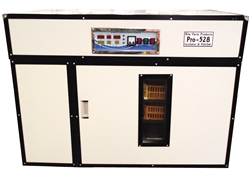
Best Deal for the money!
Rite Farm Pro-352 EGG Cabinet
Incubator & Hatcher
Only $1,049.99
+ S/H
Extra parts available at very affordable prices. Example: I was able to get an extra main Heating Element, Humidity Heat Element, Turner Motor, Main Fan Unit, Ventilation Fan Unit. Also, available is the complete Computer Control Panel for just $125..
Other sizes available from Coops-N-More.
Pro-264 chicken egg, Pro-352 chicken eggs, Pro-440 chicken egg, Pro-528 chicken eggs (above), Pro-1056, and the Pro-2112 chicken egg sizes incubators available. Of course you can hatch all bird eggs in them http://www.coopsnmore.com/
We own both the Rite Farm Pro-1056 and GQF-1502 and recommend both companies, but needless to say, we recommend purchasing the Rite Farm Professional Series incubators because of holding a lot more eggs, professional Digital Humidity Control (makes a big difference), full set of (12) chicken/pheasant egg trays, and full set of (12) Hatching Trays, so you can hatch all eggs set at once. Quail and other Egg Trays sold separately. Our Pro-1056 Incubator holds 2652 quail eggs single stacked or 5304 quail eggs double stacked, but will need additional Hatching space to hatch double stacked eggs.
Please Note: No matter what incubator you purchase, you should always purchase an extra set of working parts, Control Panel/Thermostat, Fans, Heaters, Turners, etc. so you will not lose the eggs in the incubator when something stops working. Nothing works forever and spare parts are always important to have on had, no matter how small. Even if the part is guaranteed, it will likely take way too long to receive the replacement part, if one is not on hand. You still can get a replacement for the guaranteed part. Eggs can last without incubation for 24 hours. We use to get pheasant eggs from local farmers late at night, that all felt cold to touch. The farmers had collected them early that morning after killing the hen while mowing. Surprisingly they would all hatch out perfectly and hatched even better rates than my own eggs in the same incubator. This happened many times with excellent results, so do not give up on your eggs if you find the incubator was not working for a while. It is much worse to over heat them. We lost a whole incubator full of eggs because of a old thermostat got stuck on and the temps got up to 103 F. We have NEVER TRUSTED a one thermostat and will add a simple $10. digital thermostat from ebay, set to turn off heat at 101.5 F just in case something happens to the main thermostat set to turn off at 100 F and on at 99 F. This has saved our eggs several times over the years.
The ONLY complaints about incubators online are all when important parts stop working.
Tips for Rite Farm Cabinet Incubators
When we got our Pro 1056 cabinet incubator, I noticed that the trays were only turning about half way, so I adjusted the stops by bending them, so the trays turned as far as they could, just about touching the floor of the incubator, both ways. This was not mentioned in the directions at all, so unless someone with experience in incubation of bird eggs, who would know. It could have been changed while shipping, but the likely hood is small as it is sealed inside and they were both set at the same stop level. Basically, the eggs are sitting on a seesaw, tipping one way and then tipping another way, almost turning the egg completely over every 1.5 hours. If I had not done this, it would have barely turned the eggs at all and we would likely have not gotten any good hatches at all no matter how well the temperature and humidity was kept. Other than that I followed the directions, but noticed that while running the exhaust fan kept turning on causing the temperature and humidity alarms to buzz until they were restored. At first I thought the exhaust fan was doing this to bring fresh air into the incubator when needed, but I found the alarms nerve racking and it was wasting energy and kept the eggs cooled down for no reason. Since it kept doing this over and over again, it seemed crazy that something was triggering the emergency exhaust fan to kick on, blowing out all perfect temperature and humidified air out into the room and triggering both the temperature and humidity alarms to going off every 15 minutes or so.
I looked at the program the computer was using to control the temperature and humidity and the exhaust fan. I read that the exhaust fan was set to only turn on every 2 hours for 30 seconds for important ventilation, no where near every 15 minutes. The factory setting for the temperature high was 100 degrees Fahrenheit and the low was set at 99 degrees Fahrenheit and the High Alarm was set at 101 degrees Fahrenheit and the Low Alarm was set at 98 degrees Fahrenheit maintaining a perfect average Temperature of 99.5 degrees Fahrenheit. Since this looked like it was working perfectly, stopping at 100 degrees F and turning on at 99 degrees, it must be something else triggering the alarm and exhaust fan.
I then checked the Humidity settings and it's factory High Setting was set at 60% and the Low Setting was set at 55%. The Humidity Alarm Settings were set at 65% for the High Alarm and 45% Low Alarm. The Humidity is controlled by a heater in the water pan. The heater was going on at 55% and going off at 60% Humidity. Seemed good, but with heating water to raise Humidity is very different from heating the air with a fan blowing the Temperature around the control 24/7. It took time for the control to ready the 5% Humidity fluctuation, so what was happening, the heater would heat the water until almost too hot to touch and water unlike air takes a while to cool down. So once the control read the Humidity was 60%, the heater went off, but the hot water continued to raise the Humidity past 60% to 65% triggering the Alarm setting at 65% and triggered the exhaust fan until the Alarm level went off. This also blew out all the warm air with the Humidity and the Temperature Alarm went off as soon as the Temperature dropped down below 98 degrees Fahrenheit, so now the heater needs to heat the whole incubator back up to 100 degrees Fahrenheit.
If we want an average of 60% for incubation and 70% for hatching, we need to maintain as close to 60% as possible for incubation. It made sense to me if the Temperature was best maintain within one degree, why cannot the Humidity be set at 1%, so we changed the Humidity Settings for incubation to 60% High and 59% Low and 70% High Alarm and 40% for a Low Alarm. To Hatch we change the Humidity Settings to 70% High and 69% Low and change the Alarm Settings to 80% High and 50% Low. It has run perfectly every day after that without triggering a single Alarm. The heater in the water was going on and off, just like the heater for the air and it was not getting too hot, in fact, it was keeping the water at the perfect temperature to keep the humidity at the perfect %. Everything was now working perfectly. I am going to send a copy to Rite-Farm, they customers could be pulling their hair out. The Factory Settings in the book will simply not work. Someone without my expertise in incubation and understanding mechanics might never figure it out.
The Rite Farm TEST!
We set 1200 Shipped northern bob-white quail eggs in it and hatched 1151 quail chicks on the 23rd day and they all hatched within 4 hours of each other. Basically, EVERY fertile egg HATCHED! All remaining eggs were clear, not one chick died in an egg. This was the highest % hatch we have ever hatched in 48 years including from our own eggs and the closest we ever had them all hatch. We have ONLY seen a hatch together that close and that % when setting eggs under a Bantam hen.
We got the same great hatches with our Pheasants, and four species of quail. We have also hatched turkey, ducks, peafowl, chickens, geese, and partridge with excellent hatch rates.
We planned to build a Hatching unit for the 2017 incubation/hatching season, but after adding up the cost of all the components it was cost effective to just purchased a Pro-528 (Best Deal for the bucks) and removed the turning trays (6 egg trays/baskets), by just removing 6 nuts and bolts to convert it to be a just a Hatcher unit. We just built in a stationary tray frame to hold 10 hatching baskets instead of just holding 6 turning tray/brakets, allowing us to hatch up to 10 baskets (2210 quail eggs or 1500 pheasant eggs) of the 12 egg trays/baskets from our Pro-1056 incubator. We are using the auto turning frame that came with the Pro-528 to turn our eggs we collect each day before we sell or set them increasing our hatch rate like the pros.
We will use the egg racks/trays without the hatching baskets for now on in our Pro-1056 incubator and keep it set on 60% humidity. That way we will be able to keep the main incubator clean and running the same incubation settings all season and have the Pro-528 Hatcher unit set up at 70% Humidity for all season. Just hatching eggs and cleaning and disinfecting the Hatcher unit after every hatch.
These Rite-Farm Pro incubators are so good that all we need to do is put eggs in and take them out and place them in the Hatcher 3 days before their hatch date and then take the chicks out the night of the hatch date. Very few eggs don't hatch.
We do candle the eggs weekly when we set the next eggs and remove any clear eggs we find. The clear eggs have not turned rotten yet, so are put in our compost pile. We also add all eggs shells from our hatcher to the compost. Last years compost is added to our garden.
We spray all eggs with Trek-Trol before setting and use Trek-Trol when cleaning the incubator or Hatcher. Safe to use on eggs and incubators wet and in brooders safe for chicks after it dries. It has a disinfection residue, meaning it will continue to work long after it dries even through dirt.
We also use Trek-Trol on our whelping boxes, kennels, safe for newborn pups as soon as it dries. We get Trek-Trol from Revival Animal Supplies and GQF also has it, but more expensive.
FOR SALE!
We are selling our GQF Sportsmen incubator with an old model GQF smaller Hatcher. They have served us very well for 20+ years, with many 95% hatches. We updated both thermostats with newest models and replaced all moving parts (fans, turner, etc) just two years ago. We also have lots of egg racks for chickens, ducks, turkeys, peacocks, pheasants, quail (enough to double stake), etc.. Email for more details. NO SHIPPING!
Improve Your Land for Wildlife!
Free programs for KY land owners with 30 or more acres!
Home Page!
About Us!
Llewellin Setter History!
Dashing Bondhu History!
Why a Llewellin Setter? Q&A
Our Llewellin Studs
Our Llewellin Dams
Llewellin Pups/Dogs Available!
Life-Time Guarantee!
How we raise our pups
Customer Testimonials!
Who was Richard Llewellin?
Who was William Humphrey?
Llewellin Setter Registration
Llewellin Setter Description
Hunting Photo Gallery!
Personal Comments

All documents, photographs and graphics are Copyright © 1996-2024
Background painting of GDC Dashing Blaze Bondhu, shown in her loving memory.
